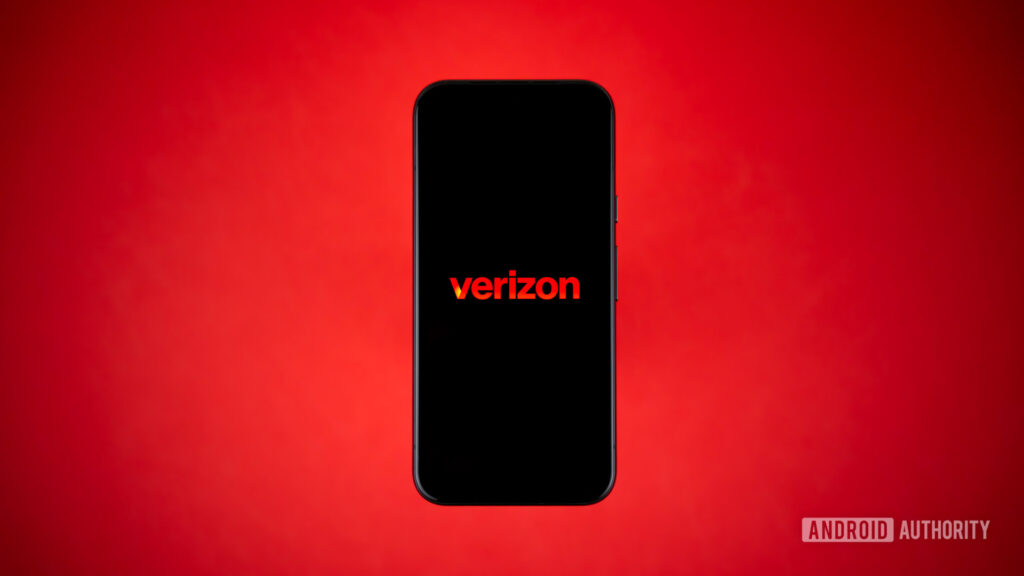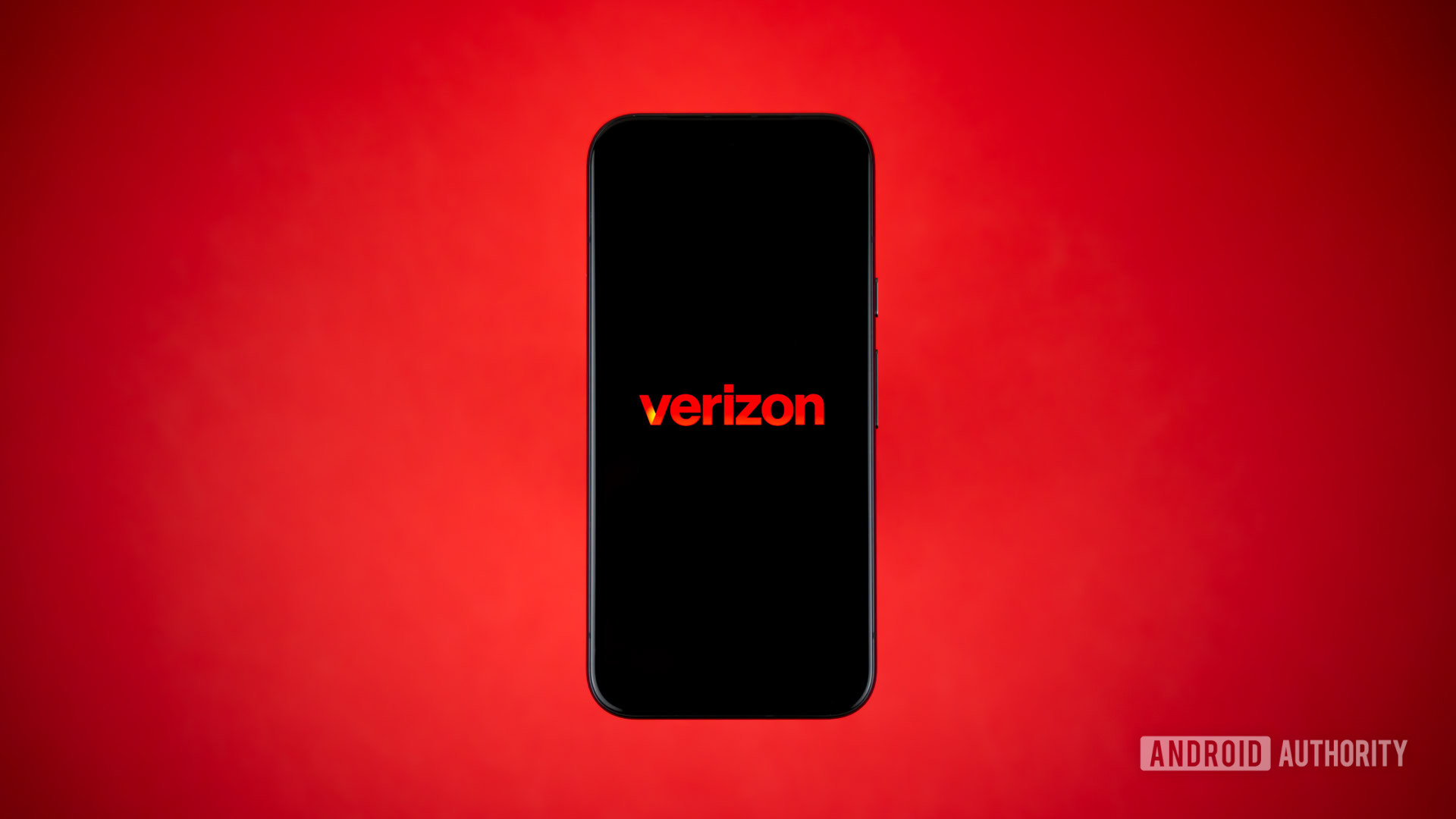
Edgar Cervantes / Android Authority
When the iPhone 14 launched, one of its key talking points was its satellite connectivity. In case of an emergency, the iPhone 14 series could connect to a low-orbit satellite and send an SOS message, even when there is no cell signal on the phone. Android, of course, wouldn’t be left far behind either.
In this guide we take a closer look at the current state of iPhone and Android satellite messaging, what devices support it, and more. This is especially important right now for those who are unfortunately impacted by Hurricane Milton, as right now consistent phone communications can be hard to come by in certain parts of the US.
What is mobile satellite connectivity and how does it work?
It’s important to understand that when we’re talking about mobile satellite connectivity we aren’t talking about satellite phones, sometimes called a satphone. While this is also a type of phone that connects to a telephone network through satellites, this older technology is clunkier, more expensive, and exclusively uses satellite tech for connections. In other words, these types of phones are made for those who travel to extremely remote places as they’ll work just about anywhere.
As you can tell, this is unlike our modern-day smartphones, which connect to ground-based cell towers. When you move from one cell to another, your phone switches cell towers to latch onto the closest cell tower. However, your phone will lose signal if a cell tower is not nearby. You will not see any network connection on your phone, you will not receive any network services, you will not be able to receive any calls nor send any messages, and you will not be able to access the internet.
So what is mobile satellite connectivity then? In short, it’s the ability for a standard mobile phone to connect to a satellite network in the case of emergency situations.
Satellite connectivity on modern smartphones
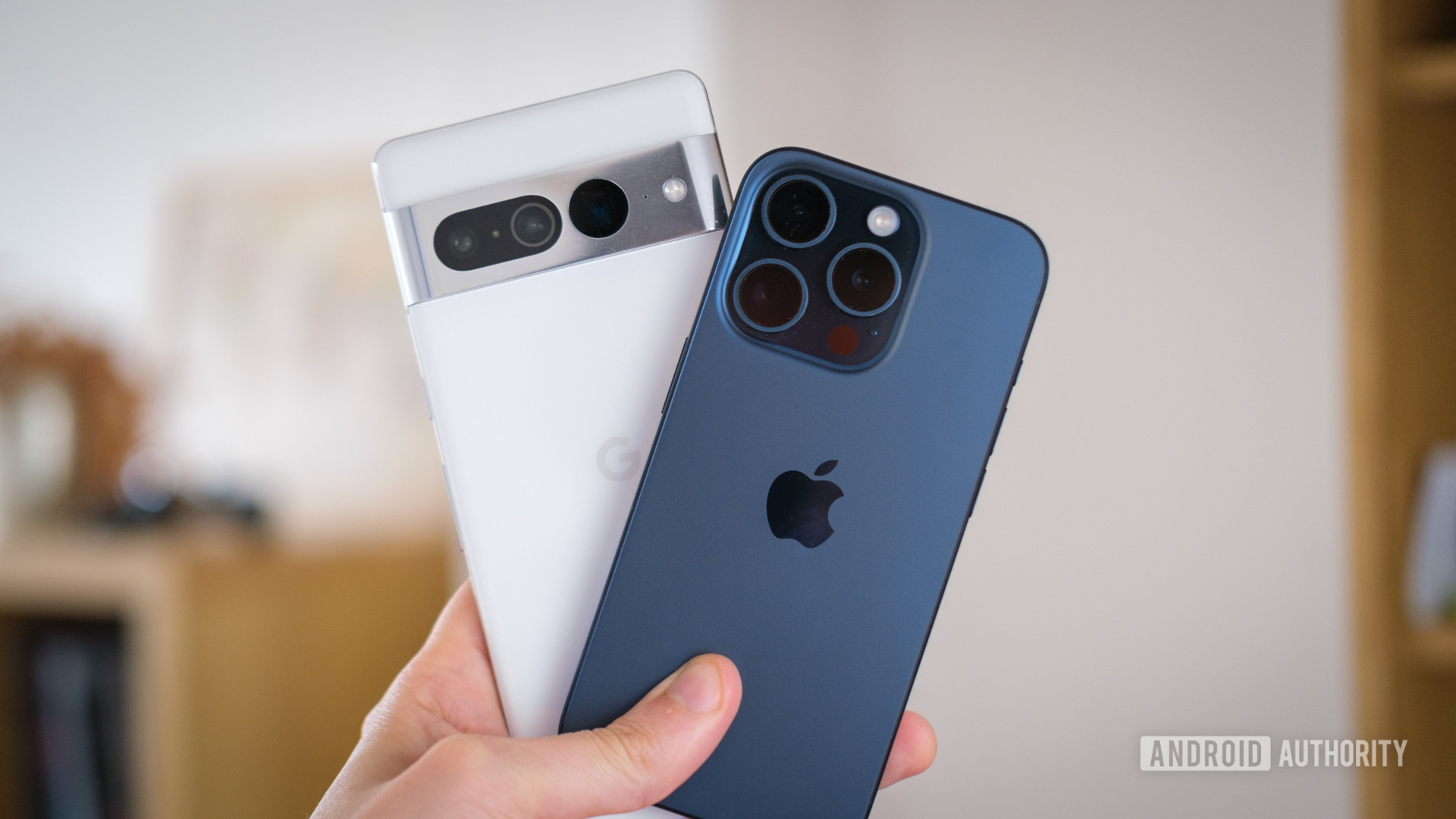
Robert Triggs / Android Authority
Satellite phones have historically remained a product that served a very narrow niche. Because of their special connection needs, satellite phones need different connectivity hardware than cell phones.
Smartphones are gaining satellite connectivity primarily for emergency and SOS communication.
However, cell phones have evolved into smartphones that can do more than connect to a cell network and let you call or send text messages. The tech has evolved enough to the point where some level of satellite connectivity can be added to modern smartphones. For instance, smartphones may not entirely replace dedicated communication units on ocean liners, but individuals can use them for emergency communication and distress signaling. We fantasize about a future where the modern smartphone works equally and seamlessly across cellular and satellite networks.
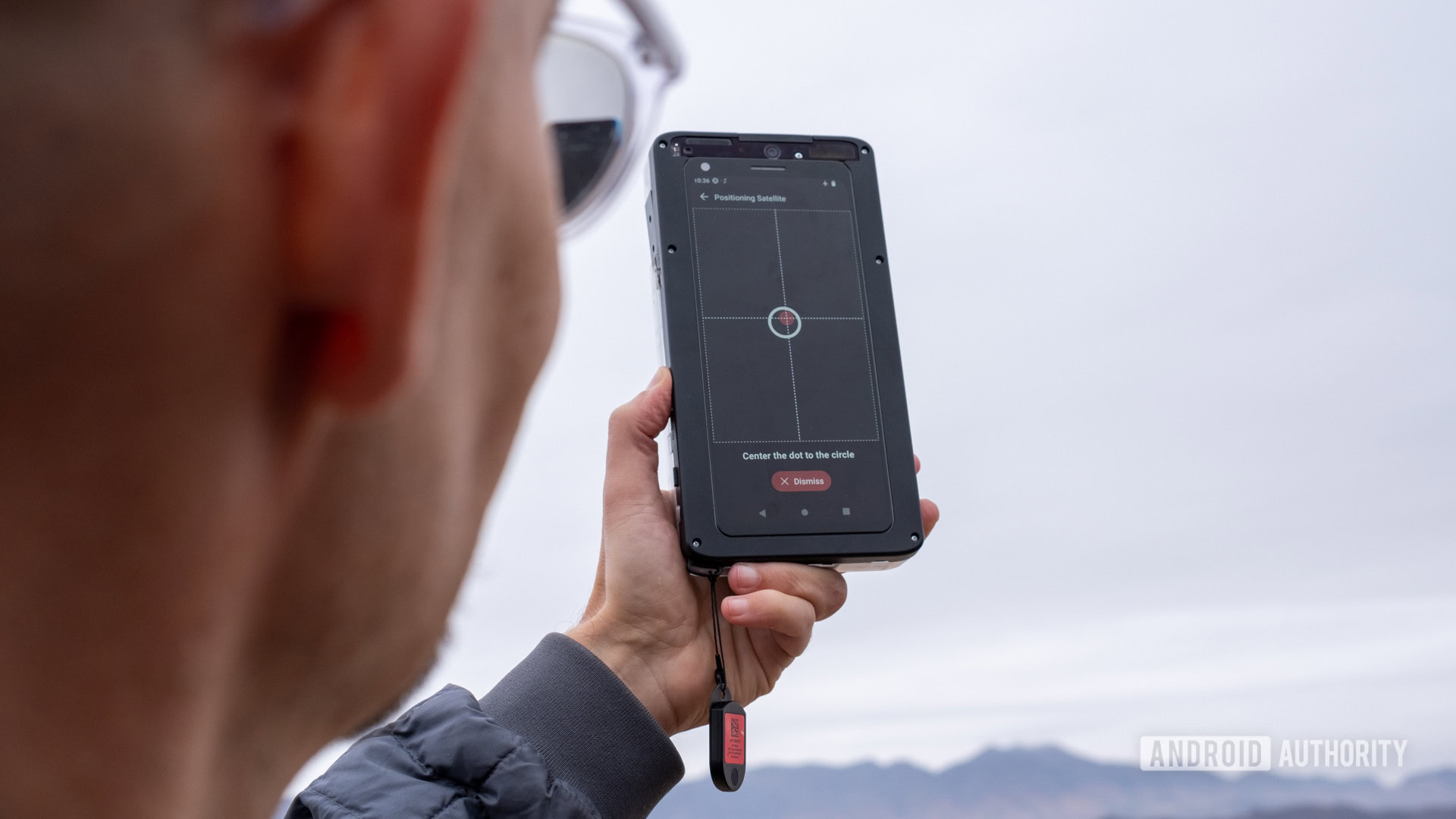
Ryan Haines / Android Authority
For now, though, most of the available or demoed satellite connectivity options on smartphones focus on SOS messages. In the near future, we can expect to see two-way messaging as well, and some months down the line, we hope to see internet data throughput as well.
Can my current phone or network connect to a satellite for emergencies?
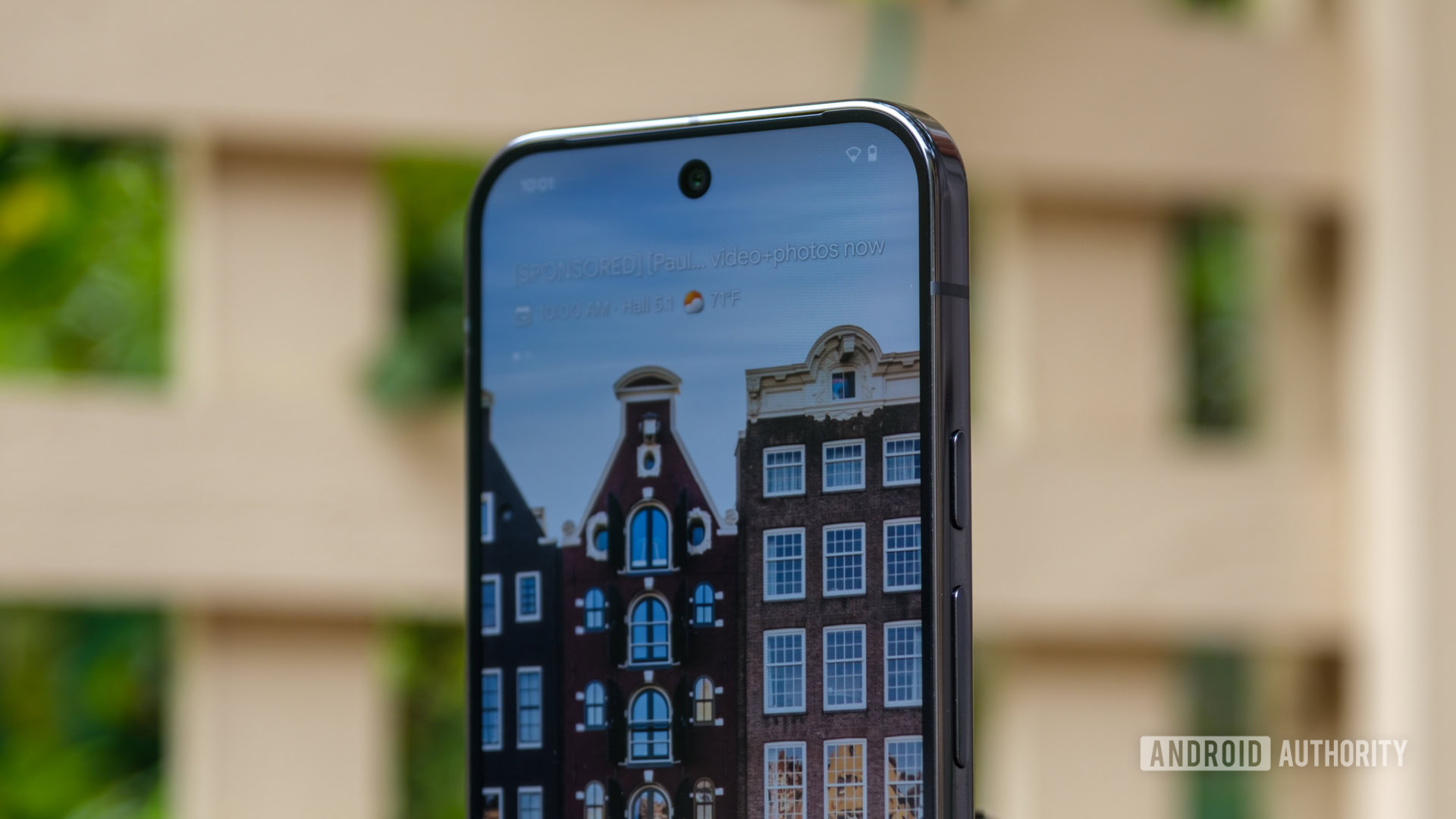
Ryan Haines / Android Authority
While there are tons of efforts to bring satellite connectivity to Android users, most of these efforts are far from ready for primetime. Right now you pretty much have two paths if you want to use satellite connectivity on a smartphone: get an iPhone 14 or newer, or get the Google Pixel 9.
If you currently own either device, you can turn on and use emergency SOS features now which will enable Android satellite messaging and other basic emergency functions. This is extremely helpful for those who are currently affected by Hurricane Milton, as conventional cellular communication lines are pretty jammed during a crisis like this.
What you need to know about Apple’s Emergency SOS via satellite
- Works with the iPhone 14 and iPhone 15 series.
- Available to use since November 2022 in select regions.
Satellite communication on smartphones became a topic of conversation thanks to Apple. The iPhone 14 and its siblings were the first set of smartphones widely available in the market that support satellite connectivity, though the feature has since come to the iPhone 15 and iPhone 16 families as well.
Apple takes a hardware-centric approach instead of a network-centric approach like T-Mobile. You must have one of the eight iPhone 14 or iPhone 15 devices to access this feature. The feature does not work on older iPhones due to the lack of specialized antennas for satellite communication. So, don’t expect the feature to arrive on older iPhones.
The feature was available in the United States, Canada, the United Kingdom, Ireland, Germany, and France at launch, but more countries have been added since. These include Australia, Austria, Belgium, Italy, Luxembourg, the Netherlands, New Zealand, Portugal, Spain, and Switzerland. Note that the feature is free for the first two years, and Apple hasn’t detailed what it will be charging after this period. It has partnered with satellite provider Globalstar for this service.
Since the feature requires a direct line of sight with satellites, Apple also built a special interface to help users position their devices optimally. To use the feature, you must be in a location without a network signal and dialing for an emergency. The iPhone will then suggest emergency SOS via satellite and forward your text and location to the nearest emergency service. There’s also a ground relay service that will call emergency services if they do not accept texts.
Note that Apple’s Emergency SOS service is a one-way messaging service and does not support receiving responses to the messages sent out. But since the service went live in November 2022, it is indeed the first service to be actually available to consumers in a mass market product.
What you need to know about the Google Pixel 9’s Satellite SOS
- The Samsung Exynos 5400 modem in the Google Pixel 9 series powers the phone’s Satellite SOS feature.
- This modem is also used in the Galaxy S24 and S24 Plus, but neither of these phones offer satellite smarts.
- Samsung’s older Exynos 5300 modem, found in the Galaxy S23 models, also supports satellite connectivity, but Samsung has not enabled this feature.
Samsung has also joined the race with its Exynos modems. The Exynos 5300 modem was the first example, enabling two-way satellite messaging like its industry peers. Despite featuring in the company’s recent flagships, no Samsung phone currently supports satellite connectivity features.
However, Google rolled out Satellite SOS to its flagship smartphone range with the Pixel 9 series, which uses the newer Exynos 5400 modem. The feature allows users to contact emergency services via Google Messages even without coverage. Like Apple’s implementation, Google offers Satellite SOS to Pixel 9 buyers for free for two years, after which a subscription is required.
Android satellite messaging: upcoming carrier options
While there aren’t many other solutions out there, the good news is that plenty of alternatives are on their way, including several efforts by the three major carriers.
Verizon

Edgar Cervantes / Android Authority
- Who is partnering to provide service? Skylo might not be as well known as Starlink but this NTN communications company will handle satellite emergency connectivity using its unique firmware-based technology. This is the same provider behind the Pixel 9’s sat features, by the way.
- When can we expect it? Verizon announced the partnership in August and promises it will launch this fall, though there’s no specific timeframe provided.
- Will I need a specific phone to use it? No, similar to Starlink you can use any phone but the big difference is that the company doesn’t even require special satellites as it uses existing infrastructure.
- How much might it cost? There’s no word on costs, though it likely will be included with at least some of the more expensive plans. An optional monthly fee for cheaper plans seems likely though.
Verizon is actually the only one of the carriers that is making it clear it will launch this feature in 2024, though it could easily miss its promised deadline as we’ve seen from pretty much every other attempt to bring satellite emergency technology to a wide range of phones. There are not tons of details on how much the service might cost, though it’s very likely at least some plans might include the functionality for free.
One big difference between Verizon and T-Mobile’s solutions is that the former uses traditional satellites in space, while the latter uses low-earth orbit satellites which provide faster connectivity and better reliability. For basic messaging, this likely won’t have a notable impact, but as satellite technology improves and backup satellite data becomes possible, it will certainly matter more.
T-Mobile
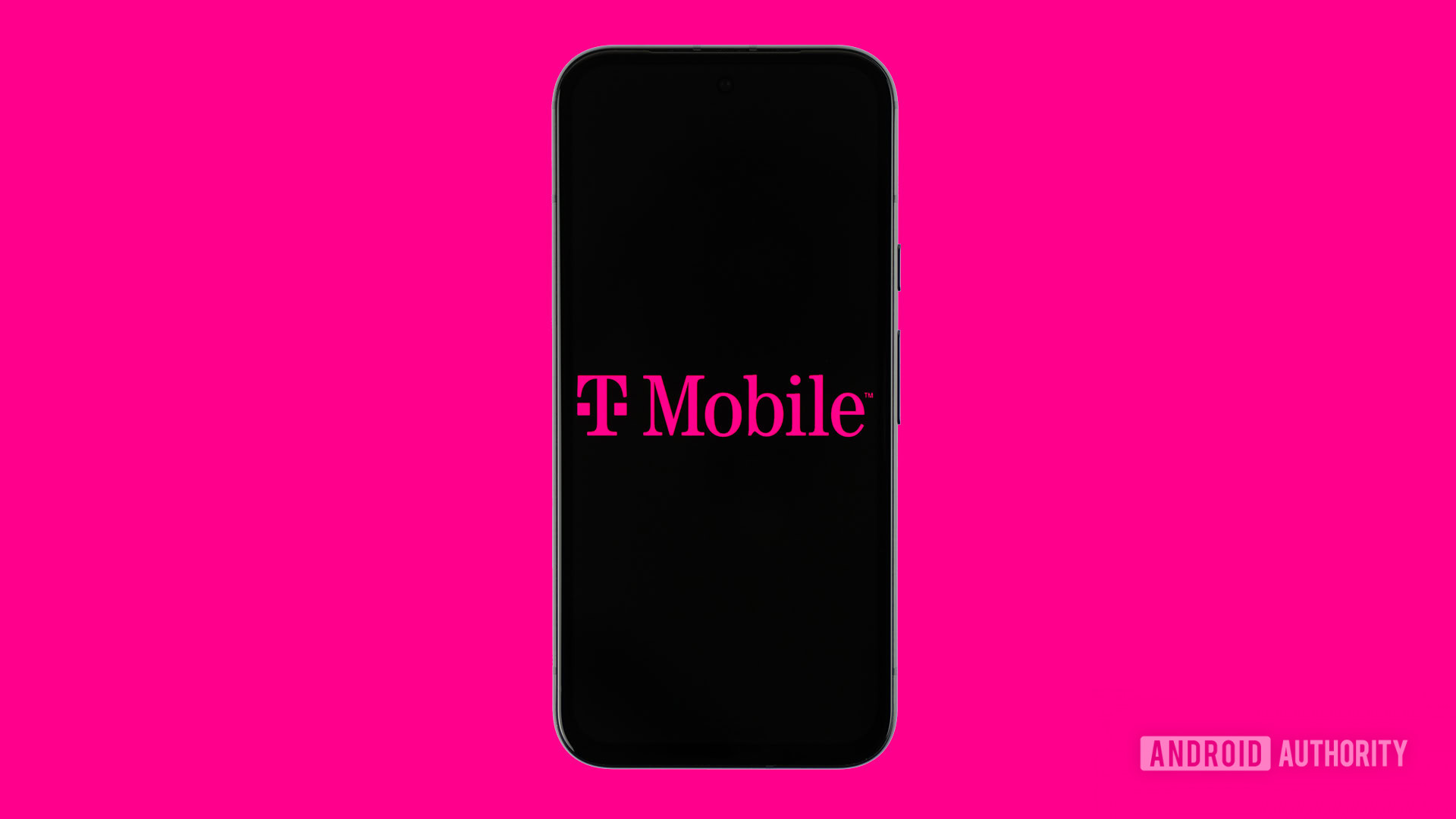
Edgar Cervantes / Android Authority
- Who is partnering to provide service? Starlink is behind T-Mobile’s effort, which means it should be impressive when it launches, but it also means it has been subject to constant delays, something Starlink kind of has a reputation for.
- When can we expect it? While it was originally expected to launch in late 2023 numerous hardware and regulation hurdles have slowed things down. There’s no exact would when we’ll see it go live, but Starlink has launched satellites technically capable of the feature so either a late 2024 launch or early 2025 launch seems probable.
- Will I need a specific phone to use it? No, any existing or upcoming 5G smartphone will play nice with the satellite connectivity as it connects to Starlink’s satellites using cellular technology and so a specialized satellite modem isn’t required here.
- How much might it cost? T-Mobile has not expressly detailed any further pricing information on the plan but said it will aim to bundle it for free on T-Mobile’s most popular plans.
When leaks and rumors pointed towards an imminent satellite connectivity launch on the iPhone 14 series, T-Mobile announced its partnership with SpaceX to provide satellite connectivity on smartphones through Starlink satellites. The highlight of this partnership is that you don’t need a dedicated satellite phone or even satellite connectivity tech in your phone to use it.
Years after its first announcement, T-Mobile and Starlink have yet to release their service but the partnership is getting closer. In January 2024 SpaceX launched satellites with Direct to Cell technology, which will allow the satellites to act as “a cellphone tower in space,” according to Starlink.
SpaceX’s Starlink satellites will broadcast a new network on T-Mobile’s 1900MHz mid-band spectrum, so your existing 5G smartphone should be able to connect to it just fine. So when a T-Mobile subscriber does not have a ground cell tower nearby, they can connect to this new network, send SMS, MMS, and use “select messaging apps.”
Voice and data connectivity are promised to be added in the future, though it would be wise to keep your expectations grounded. A message could take half an hour to go through, so don’t expect it to replace your 5G plan anytime soon.
AT&T
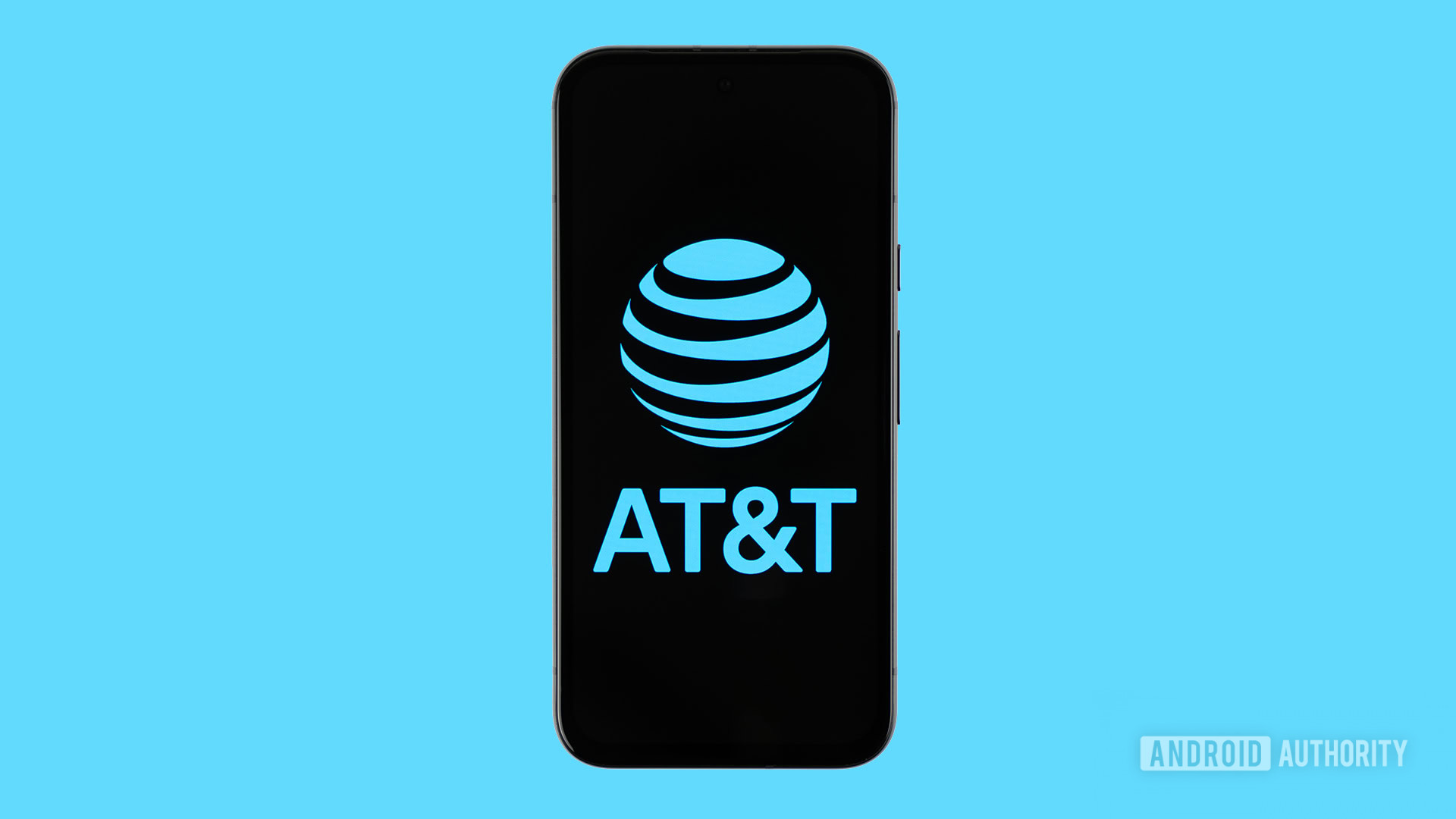
Edgar Cervantes / Android Authority
- Who is partnering to provide service? AST SpaceMobile will provide space-based emergency services through a partnership that will extend to at least 2030.
- When can we expect it? AST launched its first five commercial lowe-earth orbit satellites this summer but there’s likely a lot involved before it’s up and running in any meaningful way. At best case we’d say a mid-to-late 2025 launch would be possible, but even longer isn’t unreasonable considering the network is still in the relatively early stages.
- Will I need a specific phone to use it? Again, no, you won’t need specific equipment for this solution.
- How much might it cost? AT&T has yet to talk pricing, though we’d say it will likely be free for basic use on certain plans but with charges for more advanced functions or for cheaper plans that don’t include the feature.
AT&T is the latest to the satellite race, announcing a partnership with AST SpaceMobile back in May of 2024. While the companies have launched the first five test satellites, it’s pretty clear we are still in the early days here. The fact that the partnership extends to 2030 means we’ll likely see these features hit AT&T in the next few years but there’s no guarantees whether it will stay with AST long-term.
Other upcoming mobile satellite messaging systems
There are a few other efforts beyond the carriers. While some, like Qualcomm’s failed effort, have since died, here are two worth showcasing:
Android Satellite connectivity support
Android 15 extends platform support for satellite connectivity. With the Android 15 Developer Preview 2 release, the platform now has UI elements that are needed to “ensure a consistent user experience across the satellite connectivity landscape.” As part of these changes, apps can use APIs that allow them to detect when a device is connected to a satellite, which can give the app more awareness of why full network services are unavailable.
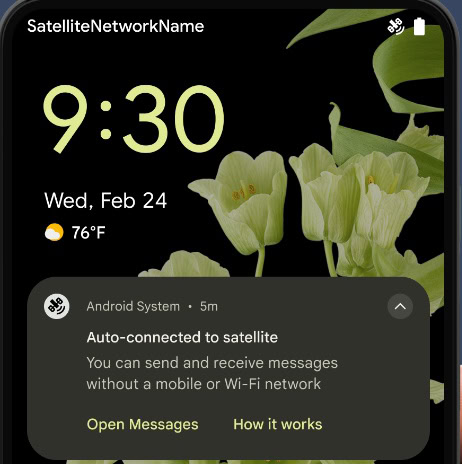
Android 15 also provides support for SMS apps and preloaded RCS apps to use satellite connectivity for sending and receiving messages. This means that satellite connectivity will not be limited to emergency uses only.
This is what the Satellite Messaging page within Android 15 could look like:
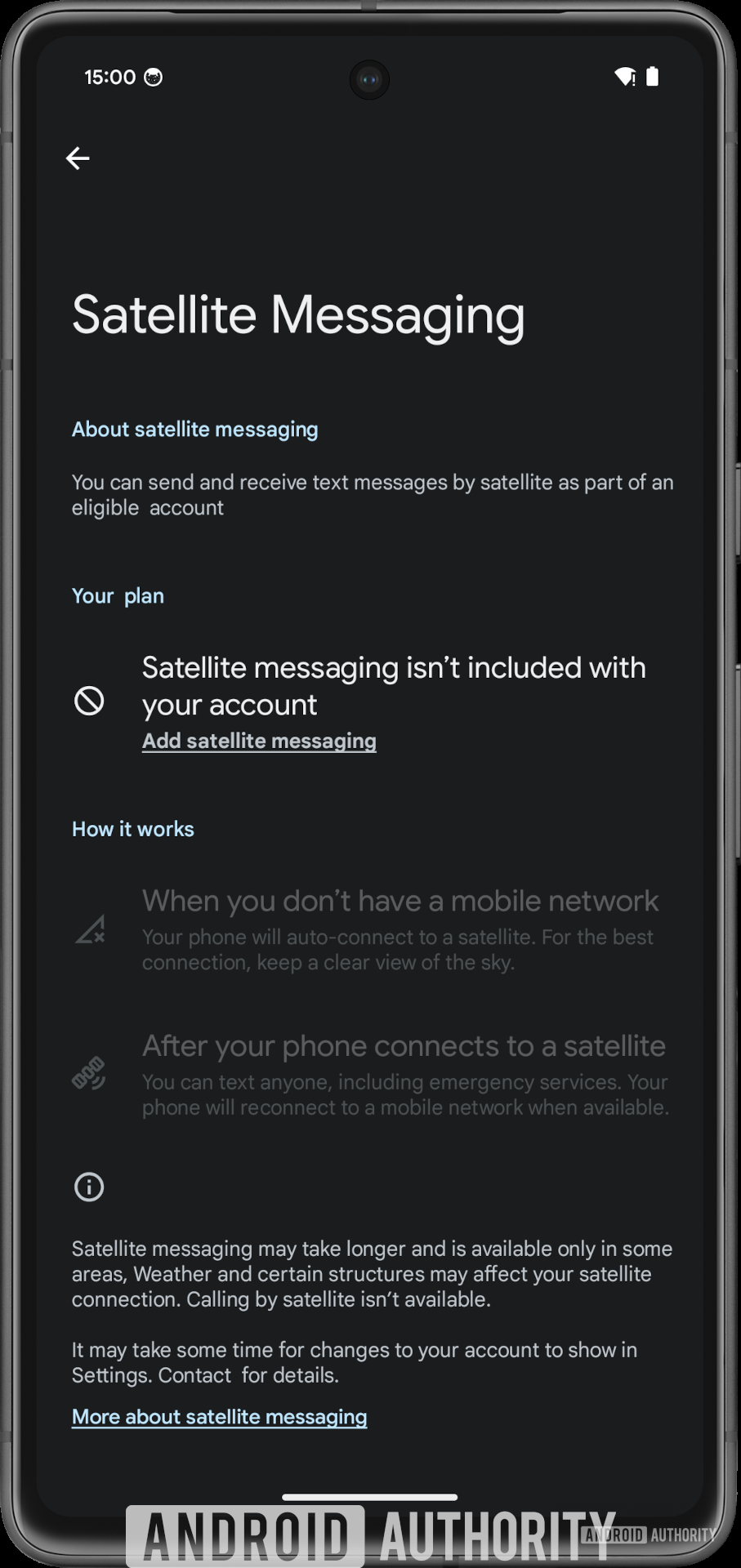
Mishaal Rahman / Android Authority
The satellite messaging provider is not immediately clear from the screenshot, but the buttons present on the screen lead to a T-Mobile satellite coverage page, suggesting that T-Mobile could be Android’s satellite messaging provider. In turn, T-Mobile is partnering with SpaceX for satellite-to-phone connectivity.
As we can see from the strings and the surfaced screenshot, when you add satellite messaging to your T-Mobile plan, you will be able to send and receive text messages to any account (and not just emergency services) when you are in an area with no cell service. You will need a clear view of the sky, and the connection could be impacted by weather and other structures. When you are in the range of a mobile network again, your phone will disconnect from the satellite and reconnect to cellular services again.
Google has announced satellite connectivity for the Android platform but has not yet revealed details about this T-Mobile centric-partnership. You can force invoke the above screen by invoking the android.settings.SATELLITE_SETTING Intent action in Android 15 Developer Preview 2.
MediaTek’s Satellite connectivity chips
- Standalone chips can be used irrespective of the brand of the primary SoC.
- Motorola Defy 2 / CAT S75, Motorola Satellite Link announced, is available for pre-order in some regions.
MediaTek first showed off two chipsets that can enable two-way satellite communication on smartphones back in 2022. MediaTek’s approach is unique because both are standalone chipsets based on an open, non-proprietary standard. Hence, they do not require smartphones to have a MediaTek CPU. This lets phone manufacturers add satellite connectivity features to any 4G or 5G smartphone, regardless of its primary SoC.
We saw this chip on the Motorola Defy 2/CAT S75 and the Motorola Defy Satellite Link. However, the Bullitt Group behind that product has declared bankruptcy and shut down. The stubs below remain for historical purposes. Unfortunately, we haven’t seen much else from MediaTek but that doesn’t mean it won’t bring us more devices with the tech in 2025 and beyond.
Do I need satellite connectivity on my phone?
As we established at the beginning of this article, satellite connectivity has important but admittedly niche and limited uses. Right now, it has constraints, and as consumers, the cost will be one of your primary concerns. Satellite connectivity on your smartphone is not going to be cheap: It either comes as an upfront cost of a new device like the iPhone 16 (which is also only free for two years and could be any price after that), or it will be tied to a subscription model that will charge per message. Unlike what you may be used to paying for SMS, this cost may appear exorbitant.
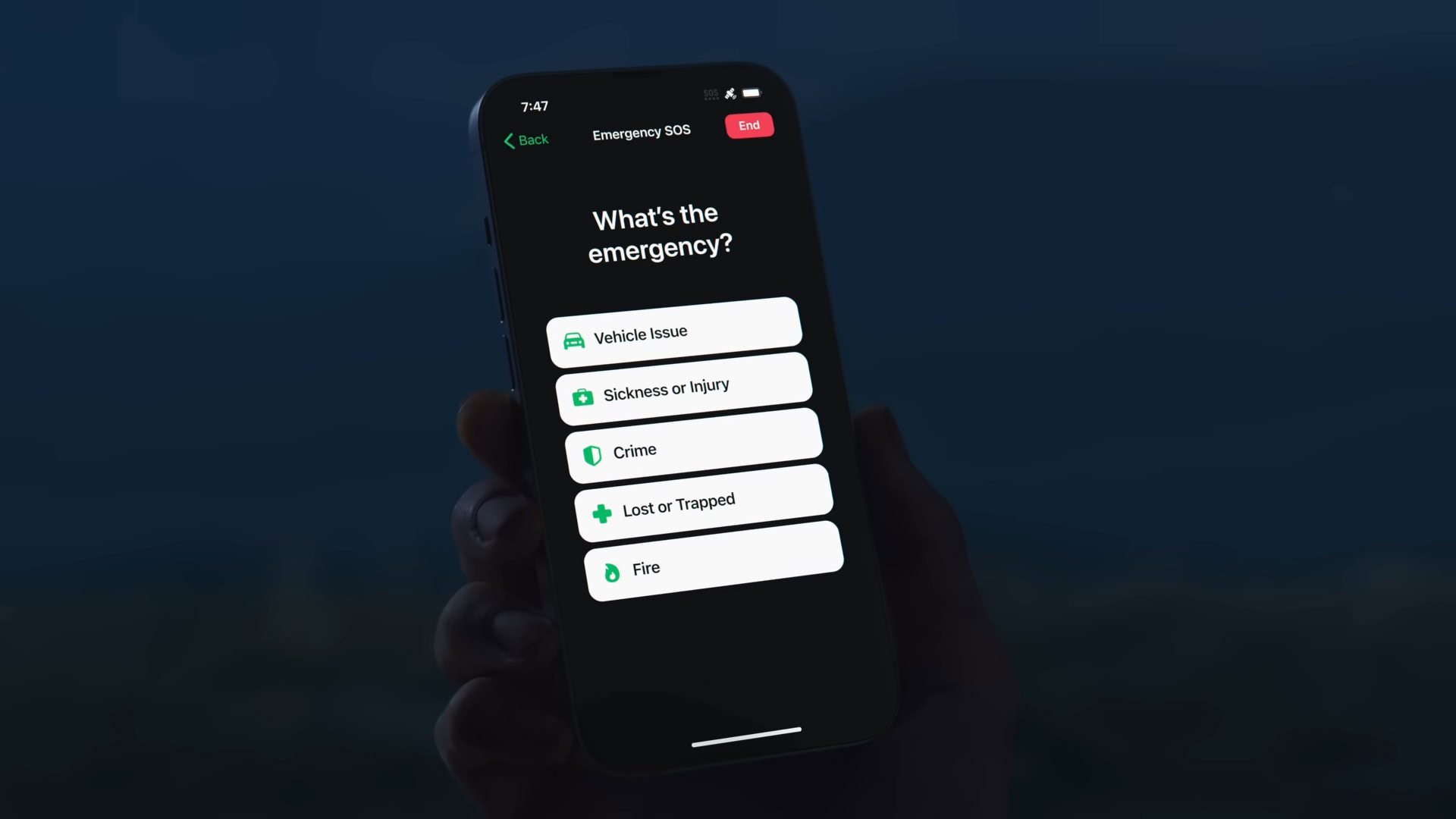
But looking at the use cases, they do appear justified. Remember, emergencies don’t show up with an announcement. You never know when you are in an unfortunate situation where you need to dial an emergency number but have absolutely zero cell network. The probability of such a situation is higher if you frequently visit less-populated areas notorious for bad network reception.
Ultimately, whether you should prioritize satellite connectivity on your smartphone will boil down to you as a consumer. If you don’t see yourself leaving the confines of the city, and all your adventures are on the beaten path, satellite connectivity may have very limited utility for you, if at all. On the other hand, having a device that still allows you to contact emergency services can be priceless if you reside on farmland or have a cabin by the woods.
If you live in a remote area, or you often venture off the beaten path, then satellite connectivity is for you.
We do expect pricing for the tech to rationalize in the coming years. We also expect the tech to become even more accessible than it already is. If the costs appear prohibitive to you today, they may appear worth it down the line for the simple peace of mind.
FAQs
Yes, the iPhone 14, 15, and 16 series supports satellite connectivity in 16 regions, including the United States, Canada, the United Kingdom, Ireland, Germany, and France. The technology is used to enable Emergency SOS features.
The Galaxy S23 series does not support satellite connectivity in any region.
No, the Galaxy S24 series does not support satellite connectivity in any region.
As of right now, satellite connectivity focuses on providing emergency SOS connections through text messages only. Internet usage is outside the current scope of the technology.
Yes, the Pixel 9 series supports the Satellite SOS feature in the US. It utilizes Samsung’s Exynos 5400 modem.
